Wowi Flower Garden
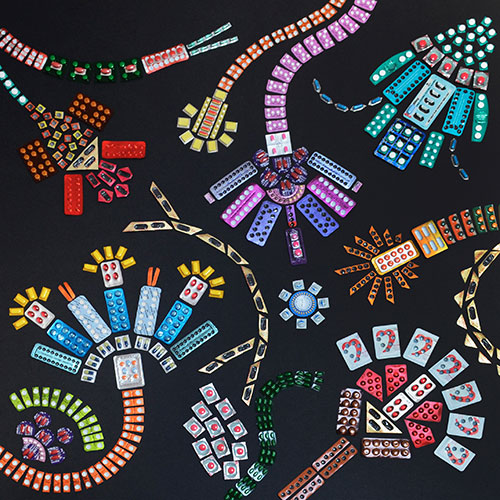
Our Wowi Flower Garden features medicines for these common conditions seen in GP surgeries on a regular basis.
|
|
Photo: Lucia Reed

Our Wowi Flower Garden features medicines for these common conditions seen in GP surgeries on a regular basis.
|
|
Photo: Lucia Reed
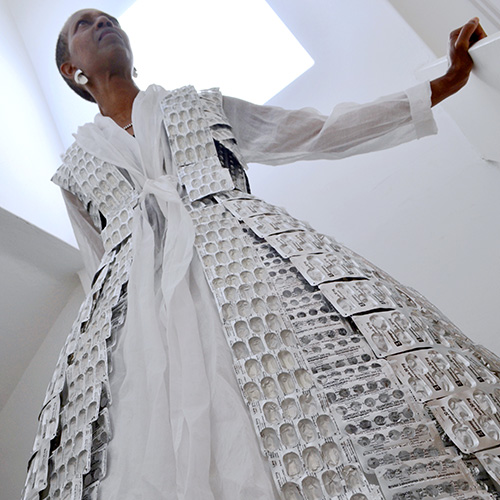 In 2018 Pharmacopoeia created a coat for Sonia with a selection of empty packets from the prescribed pills she took between July 2010 and December 2013. They include hydroxychloroquine, mycophenolate, prednisolone, nifedipine, diltaizem, aspirin, risedronate, calcium carbonate and paracetamol.
In 2018 Pharmacopoeia created a coat for Sonia with a selection of empty packets from the prescribed pills she took between July 2010 and December 2013. They include hydroxychloroquine, mycophenolate, prednisolone, nifedipine, diltaizem, aspirin, risedronate, calcium carbonate and paracetamol.
Sonia has had Lupus for 30 years. She first developed symptoms at the age of 31 but they settled when she became pregnant only to recur again after her daughter was born. She had vasculitis of the fingers, aching joints and lethargy and was formally diagnosed at the age of 35 years. Since then she has been on a number of different treatments including DMARDs (disease-modifying anti-rheumatic drugs, steroids, anti-hypertensives and some analgesics. The side effects of the drugs has meant she also takes bone protection and PPI’s as stomach protection.
Sonia reports that she is currently in very good health and takes her medication exactly as prescribed.
People love to take medicine. Our imaginations have allowed us to dream of finding compounds that will relieve our pain and suffering. With the nineteenth century transformation of the local apothecary into an industrial pharmaceutical industry our dreams have in many ways come true.
In 1887 a German pharmaceutical company first synthesized Aspirin whose active ingredient salicylic acid was derived from the bark of the willow tree. Salicylic acid is present in a number of other plants and its ability to reduce both pain and fever was first documented by the Ancient Egyptians. What must have seemed like magic was gradually turned into medicine and is now taken completely for granted.
Suffering is part of the human condition and so in spite of the availability of a multitude of medicines the search continues for both organic and inorganic compounds from which to make new pills to help us live longer, healthier and happier lives.
The concept for Pharmacopoeia’s ‘mantilha’ centres on the fact that a significant number of drugs have their origins in plants and naturally occurring microorganisms. It is well known in the UK that the heart drug Digoxin is derived from the beautiful Foxglove plant. The most effective treatment for falciparum malaria was found in the plant Artemisinin; long known to the Chinese for its medicinal properties. Most recent of all the drug Crofelemer from the red sap of the Croton Lechleri plant, and used by indigenous cultures of the Amazon, has been approved for treating side effects of HIV antiretrovirals.
Whether in the chemistry laboratory or in the rain forest it takes a huge leap of the imagination to identify and then painstakingly develop and produce a new drug. Each pill, apparently so simple, is really nothing of the sort. It is an absolute triumph and testament to man’s intelligence and ingenuity.
As a family doctor I have many patients with cardiovascular disease—not surprising as it is the most common cause of mortality and morbidity worldwide. The 52 arrows around the edge of What Once Was Imagined constitute the weekly intake for one such patient. I prescribe a combination of drugs to be taken daily including a beta-blocker, an antihypertensive, a cholesterol-lowering drug and an aspirin to help prolong their life.
Dr Liz Lee
Photo: Joana França
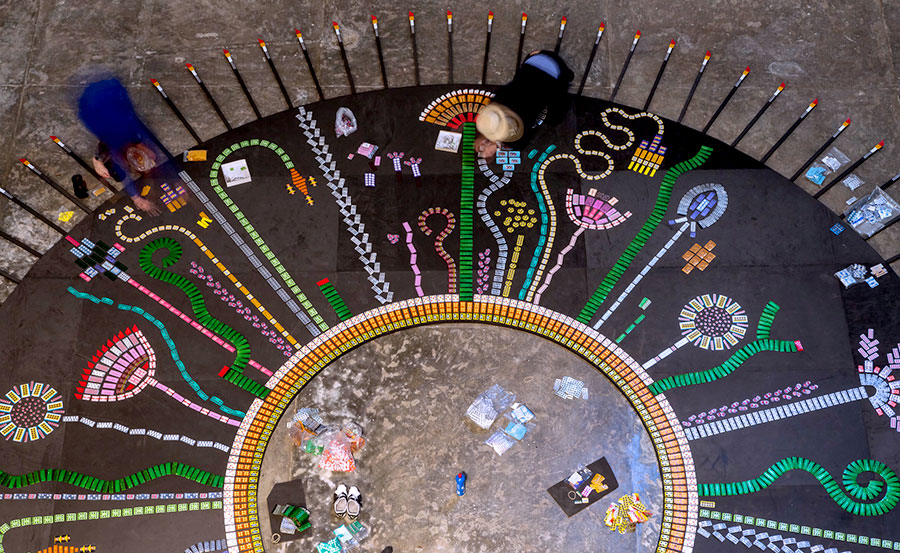
Photo: Matthew Critchley
Michele was diagnosed with Polycythaemia Vera when she was 47. For some time she had been feeling excessively tired and unusually breathless. Her GP took a blood test which showed that she had five times as many red blood cells as she should have. She had Polycythaemia Vera, one of a group of blood cancers known as the Myeloproliferative Neoplasms. Initial treatment was to take a pint of blood from her [venesection] and this was repeated every month for two years. She then started chemotherapy with the tablet Hydroxycarbamide and so far has not needed further venesection. Sadly her fatigue persists and she is vulnerable to infections which significantly reduces the quality of her life. Life expectancy for PV continues to improve as treatments are developed and the genetics associated with the condition are better understood.
Above is a collection of commonly prescribed drugs including treatment for heart disease, mental illness, infection, inflamation, hypertension, diabetes, epilepsy, cancer, pain and piles. See if you can spot any that look familiar, and point at them to see if you were right.
Photo: Lucia Reed
“Wave utilises a unique method in a traditional craft to create a metaphor that is both visual and literal. As the blue cloth ‘crashes’, layer after layer in the foreground of the image symbolising anxiety, it brings with it, ensnared within its very fabric, the remnants of the medication used to combat the same mental health problem. The cycle of anxiety/medication – medication/anxiety is thus ‘looped’ within the work, foregrounding the paradox of prescription medicine in the present day and reminding us that anxiety is as old as knitting.”
Kevin Atherton
“I made the cloth for Wave on a hand operated double bed Dubied. My machine is a 7 gauge one – in industry finer automated versions manufacture plain jersey cloths. From 2004 I started saving the empty packets from my anti anxiety medication. These foiled plastic blister packs are not recycled in the UK so go to landfill or into the oceans. Using a clear 80 denier extruded nylon yarn I cut up the pill packs and knitted seven sections to piece dye blue in my mum’s jam pan at home. I played with the pieces, wrapping myself in the seven veils and asked my daughter and my lover to take photographs. Time passed. Visiting Russell and Chapple with Keren Luchtenstein I ordered a five foot six by two foot six painter’s canvas which I later placed flat across chair backs with the blues layered on top Over many weeks as I tried to knit other works I enjoyed its presence in the studio. Then one morning I woke with a title and accepted it was time to cease repositioning with pins and stitch down the formation of the final work.”
Susie Freeman
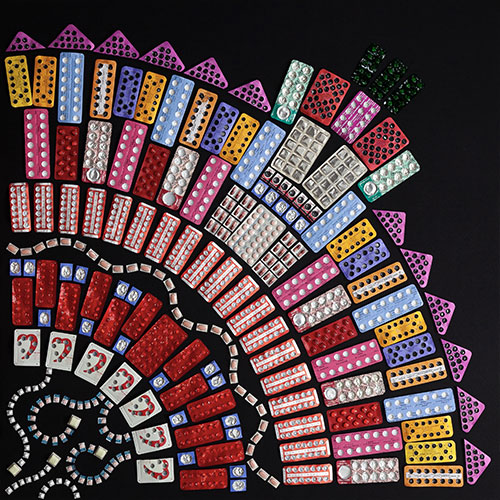
This Wowi Flower framed work is made from medicines currently used to treat diseases of the heart. Considerable crossover exists between treatments so we have displayed them as interlocking petals of one exotic bloom.
Coronary Heart Disease: ACE inhibitors, calcium channel blockers, beta blockers, statins, aspirin and clopidogrel are all regularly prescribed.
Arrythmias: Atrial fibrillation is the commonest disturbance of the heart rhythm and is treated with blood thinning medications including warfarin and Direct-Acting Oral Anticoagulants (DOACs).
Heart failure: Diuretics are added to many of the above treatments for heart failure.

When Pharmacopoeia started in 1998 we were interested in contraception. Liz Lee asked permission from her patients when removing IUDs to use them for a series of artworks we called ‘Wise Women’. We calculated how many contraceptive pills would have provided equivalent protection and knitted them into a series of dresses, coats and scarves.
By the time we reached the 2010s thinking had changed. Long Acting Reversible Contraceptives (LARCs) were in fashion, especially for young women. These LARCs have a much lower failure rate than The Pill and the NHS have been encouraging their use ever since. Here Pharmacopoeia show examples of LARCs: two IUDs and three bars of Nexplanon: the hormone delivery system inserted just under the skin of the upper arm.
Recognition – capsule medicines for common and uncommon illnesses
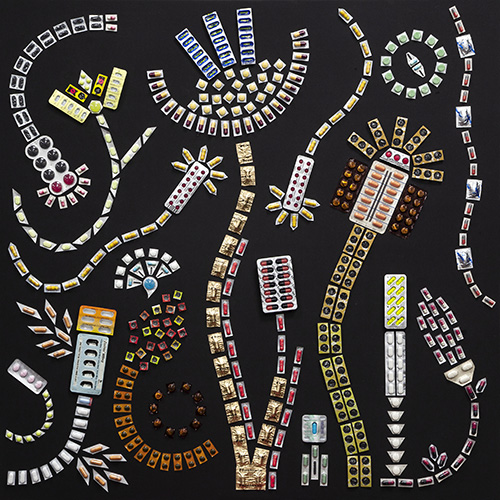
This Wowi Flower framed work is made from the packaging of medication used in the treatment of bacterial, viral, yeast and parasitic infections. Cellulitis is represented by a stem of flucloxacillin with clarithromycin tracking up the centre of the picture to a triple therapy bloom for indigestion. Two spikes of amoxycillin and prednisolone treat chest infections in a patient with COPD (Chronic Obstructive Pulmonary Disease) and there is a small cluster of penicillin for tonsillitis. There are stems of antiviral treatments for shingles and herpes and the antibiotic azithromycin for the sexually transmitted diseases chlamydia and gonorrhoea. Yellow nitrofurantoin capsules top packs of ciprofloxacin and norfloxacin used to treat urinary tract infections. An exotic malaria shoot features as GP’s prescribe prophylaxis to protect travellers from malaria parasites while TB tablets are surrounded by over the counter remedies for viral coughs and colds.
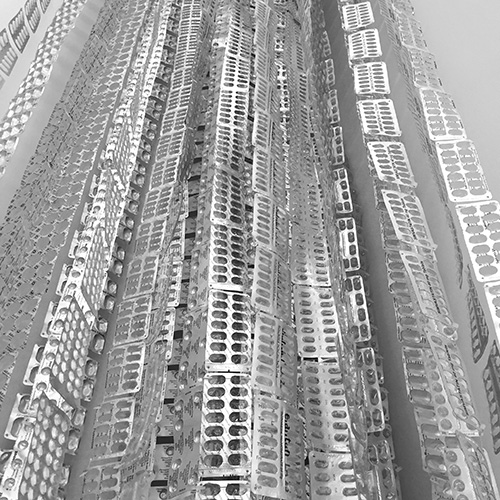 Well Pharmacy in Bristol serves Horfield Health Centre and its 16,000 patients. At our request they collected all the empty packaging from the thousands of dosset boxes they produce in one month. Dosset boxes are pill organisers mainly used by the elderly. They have separate compartments for days of the week and / or times of day such as morning, afternoon and evening. Pharmacy assistants spend hours removing pills from their original packaging and filling these Dossets. The waterfall of packaging that we have made from their collection reflects our feeling that we are drowning in medication.
Well Pharmacy in Bristol serves Horfield Health Centre and its 16,000 patients. At our request they collected all the empty packaging from the thousands of dosset boxes they produce in one month. Dosset boxes are pill organisers mainly used by the elderly. They have separate compartments for days of the week and / or times of day such as morning, afternoon and evening. Pharmacy assistants spend hours removing pills from their original packaging and filling these Dossets. The waterfall of packaging that we have made from their collection reflects our feeling that we are drowning in medication.
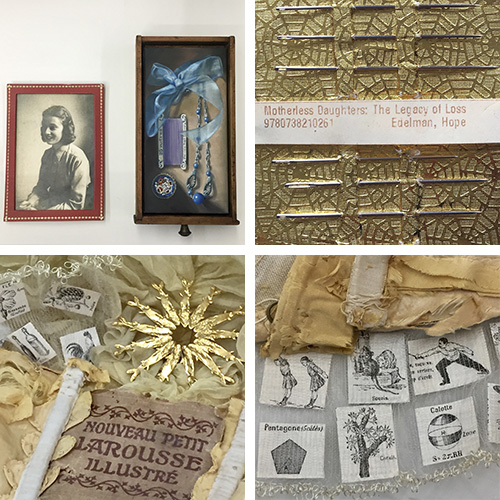 “It started with a consideration of the disease which caused my mother to die young: AIH Auto Immune Hepatitis. Research online left me cold so one day I gathered together the few possessions I have of hers including a very worn copy of a Larousse and a book she was writing about her time in a London hospital.
“It started with a consideration of the disease which caused my mother to die young: AIH Auto Immune Hepatitis. Research online left me cold so one day I gathered together the few possessions I have of hers including a very worn copy of a Larousse and a book she was writing about her time in a London hospital.
We lived in Sussex and the biography opens with Peggotty in an ambulance on a painful journey to University College Hospital on Gower Street. 10 years later I had my first child in that same red brick building, taking comfort that although mum hadn’t lived to meet Leo, Matthew or Ruby she had spent enough time in that space to write a memoir.
The book is written up by my dad on our old typewriter – thin paper with aged edges, touching memories, playing with the keys, ribbon winding – creamy well handled paper like worn cloth…
I often use corsets in my textile work and realise this stems from mum always wearing a peachy pink medical corset. Stitched panels, a zig zaggery of lacing threading through eyelets to tightly hold a velvet ‘saddle’, shaped to support the curve of her spine. She told me in her twenties she lifted a bed the wrong way and there was no going back to a back without pain.”
Susie Freeman
Materials in this installation include Peggotty’s hospital memoir, ironing board chain, french knitting spool, portrait photograph 1943, framed paper flower hearts, fish circle brooch by Holly Belsher and Ruby’s red shoes by Maryjane Stevens.
Cradle to Grave explores our approach to health in Britain today and reflects some of the ways in which people deal with sickness and try to secure wellbeing. The installation comprises three linked narratives: female/male pill diaries, objects and documents, and personal photographs.
Photo: Tom Lee
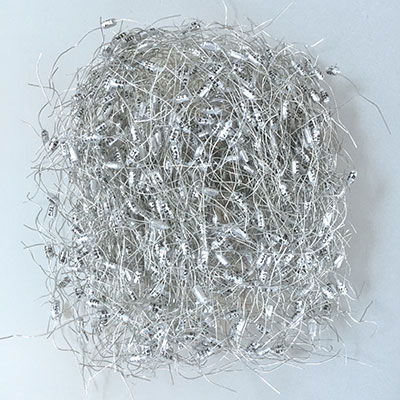
A years worth of empty packets Holly saved us from all the lozenges she sucked to resist smoking…pieced together with tiny resistors Susie acquired in 1984.
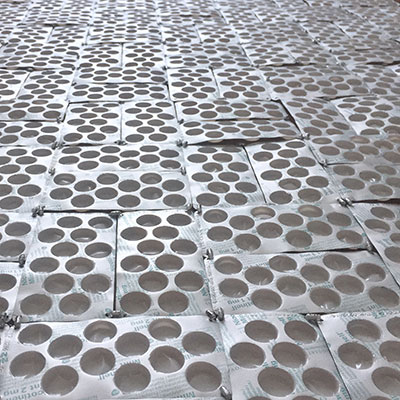
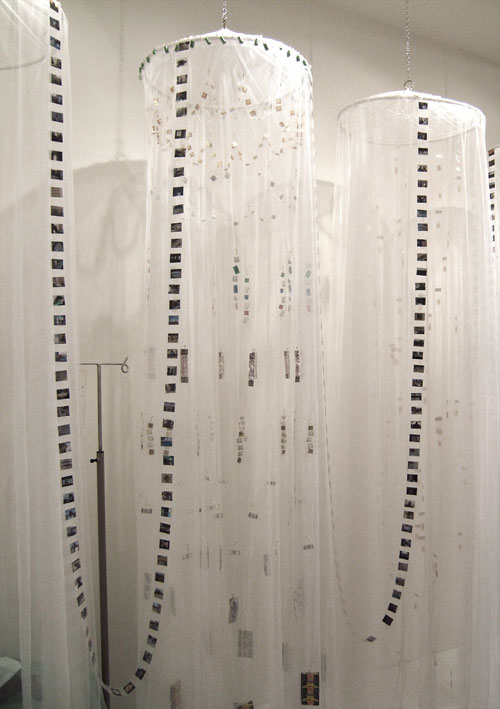
Liz Lee and Susie Freeman were commissioned in 2006 by The Wellcome Trust to research malaria in Kenya and make an artwork for their Medicine Now Gallery.
For more information about the development of the artwork, please take a look at this article.
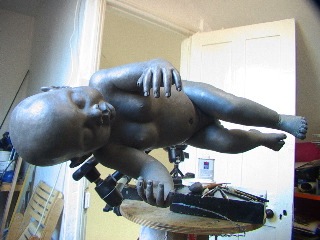
“We have shown Susie’s work in Science Gallery on two occasions – in 2008 we put together a show PILLS with a collection of Susie’s work and her work Bacteriology Illustrated was shown as part of our flagship show INFECTIOUS in 2009.
“Science Gallery vision is to ignite creativity and discovery where science and art collide – we aim to connect with and surprise our visitors with intriguing and thought provoking work. Susie’s beautifully, intricate textile work coupled with an insightful production often surprised our audiences and engaged them in a process of considering their and societies relationship with commonly prescribed drugs and the medical world generally.
“Over 13,000 visitors came to PILLS during it’s run in Science Gallery.”
Lynn Scarff, Science Gallery
“Initially I tore up a page in an attempt to isolate key words, placing each selected bite size piece in its own pocket. However, it seemed important not to discard anything.
“The dress is now formed from every page of the book. The process was painstaking and precise, each page torn into 130 pieces and placed in correct sequence to form reconstructed pages paired across the weft. Running along the warp two by two for 610 rows, there are 15,860 pockets in total. I combined the dress with a ‘doctors bag’ containing the tools of defense against infection collected in the surgery.
“The language of dressmaking and tailoring becomes layered with a different set of meanings when applied to ideas concerning infectious disease. The boned corset constrains the body, the boned book cover both holds the information within and tries to control the billowing spreading fabric.”
Susie Freeman
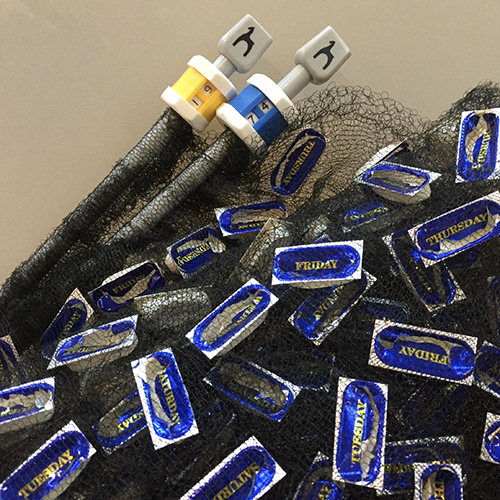 One years supply of Lansoprazol, often used to treat the uncomfortable side effect of other medicines. In the UK we spend more money treating indigestion that we do treating cancer.
One years supply of Lansoprazol, often used to treat the uncomfortable side effect of other medicines. In the UK we spend more money treating indigestion that we do treating cancer.
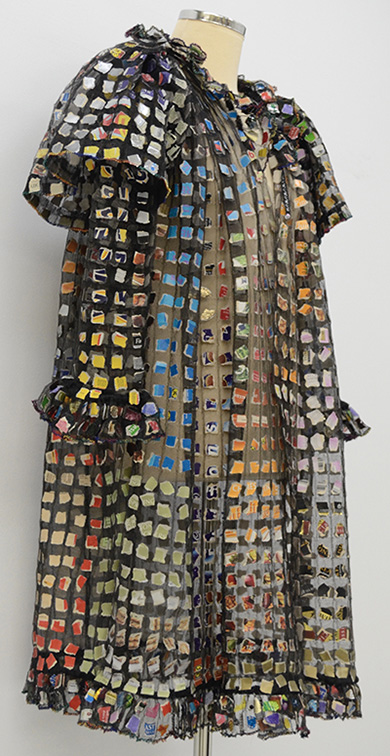 Made out of packaging from the food Susie’s family ate one Christmas day, the ghost of the family feast trapped in the pockets of the coat contains echoes of many other celebrations and days of excess. We reflect that many of us now dine like Roman Emperors every day of the week, every day is a feast day.
Made out of packaging from the food Susie’s family ate one Christmas day, the ghost of the family feast trapped in the pockets of the coat contains echoes of many other celebrations and days of excess. We reflect that many of us now dine like Roman Emperors every day of the week, every day is a feast day.
“Throughout 2010 I shot a daily photograph, made it my iPhone screen and clicked to save it with the 24 hour clock. Coping with a wave of depression in the year my dad died the process helped me feel I was managing to work creatively at least once a day. Similarly knitting with a single strand all 364 frozen time moments into one ‘year’ has helped me live through recent life events and deal with the anxiety they caused.
The title has more than one meaning. It is both a nod to technology and a memory of apples stored in the cellar of the house I grew up in. More importantly it will always remind me of someone who helped me unravel the long gone past to heal a little girl and reconcile worries, confusion and sadness sufficiently to heal herself.”
Susie Freeman
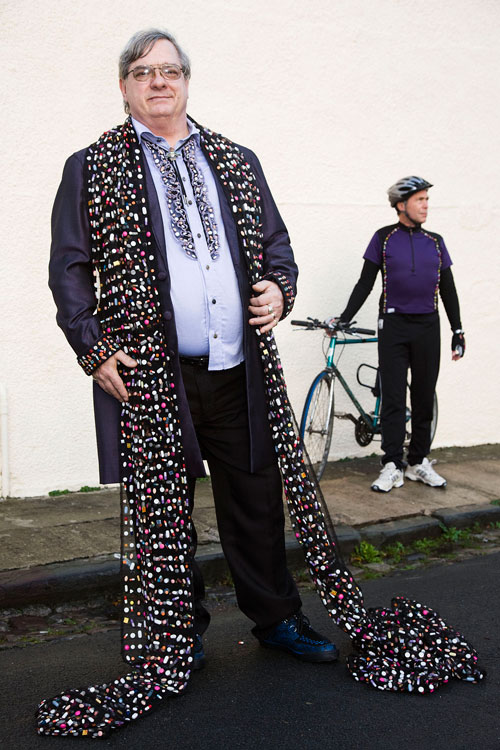 “Steve has been my patient for over 20 years and with his permission we documented all the medication prescribed to him in 2006. He has metabolic syndrome: the triad of high blood pressure, diabetes and obesity. In 2004 he had a heart attack and also suffers from arthritic knees. Taking an average of 16 pills per day, Susie pocket knitted the equivalent 5,840 pills into a very long scarf; every turn of the cloth chronologically marks the 486 tablets and capsules he took each month from January to December.
“Steve has been my patient for over 20 years and with his permission we documented all the medication prescribed to him in 2006. He has metabolic syndrome: the triad of high blood pressure, diabetes and obesity. In 2004 he had a heart attack and also suffers from arthritic knees. Taking an average of 16 pills per day, Susie pocket knitted the equivalent 5,840 pills into a very long scarf; every turn of the cloth chronologically marks the 486 tablets and capsules he took each month from January to December.
“Costume maker Jenny Graham tailored a teddy boy drapes especially for Steve and he has posed for pictures for us a number of times. There is one up in my surgery and he has a framed print of himself in the coat, shirt and pill scarf at the top of his stairs.”
Dr Liz Lee
“Working with Jenny I knitted sections to embellished the cuffs of Steve’s coat with a variety of heart disease medicines available in the UK and his pocket tops show the same for arthritis treatments. The shirt ruffle contains diabetes tablets and the coat fully lined in a silk print of all his medicines.”
Susie Freeman
Photo: Martin Parr
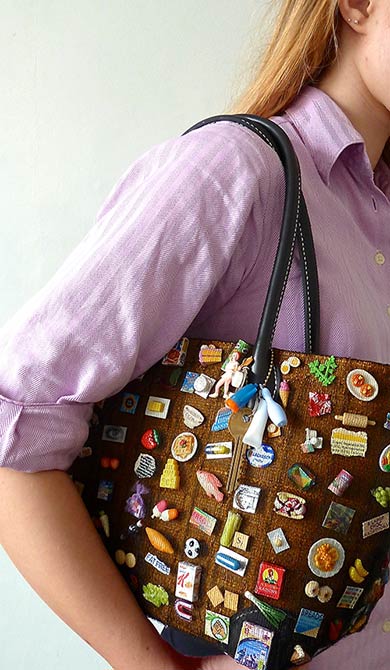 ‘Miniatures trapped in tiny knitted pockets reflect the abundance of foods; good, bad and beautiful we all navigate daily to choose what’s best for our health.
‘Miniatures trapped in tiny knitted pockets reflect the abundance of foods; good, bad and beautiful we all navigate daily to choose what’s best for our health.
Pharmacopoeia’s particular focus in this artwork is the treatment of Polycystic Ovary Syndrome. PCOS is a cluster of symptoms that frequently occur together in young women. These are acne, irregular or infrequent periods and unwanted male pattern hair growth. It is associated with changes in circulating hormone levels and with a distinctive pattern of small cysts in the ovaries. Currently more than one in ten women have the syndrome and some think the number is nearer to one in six, hence it could be argued that this is a variation of normal.
The underlying cause of PCOS is genetic. Women with the syndrome have what have been described as ‘thrifty genes’. These genes are ubiquitous within the population because they confer tremendous survival advantage in times of famine. But we live in a time of plenty and therein lies the problem.
Most women with PCOS are good at storing fat. The more fat cells they store, the more insulin resistance they develop and this drives a number of biochemical and hormonal changes which cause the unwanted symptoms. Losing weight reverses some of these changes, but the catch is that the thrifty genes make weight loss more difficult to achieve.
As a family doctor I have lots of patients with PCOS. For many it is little more than an annoying inconvenience. For others with more severe symptoms it can be devastating and there is an increased risk of developing diabetes, cardiovascular disease and metabolic syndrome.
I treat people symptomatically with the contraceptive pill to regulate periods, antibiotics for their acne and topical cream or laser treatment for unwanted hair.
I also try to prevent or minimize the symptoms altogether. The medicine Metformin, which is usually used to treat diabetes, can be regularly taken as it combats insulin resistance in cells.
However, most effective of all is to identify the syndrome early in teenagers and educate them about the need to avoid creeping weight gain. Once they understand the underlying causes of PCOS subsequent discussions about weight management and increasing exercise makes more sense. It also acknowledges girls perception that it is a bit unfair that they eat the same as their friends do but only they put on weight. Slimming tablets are available and can have a minor role in aiding an initial reduction in weight but they play no part in long term weight management.’
Liz Lee
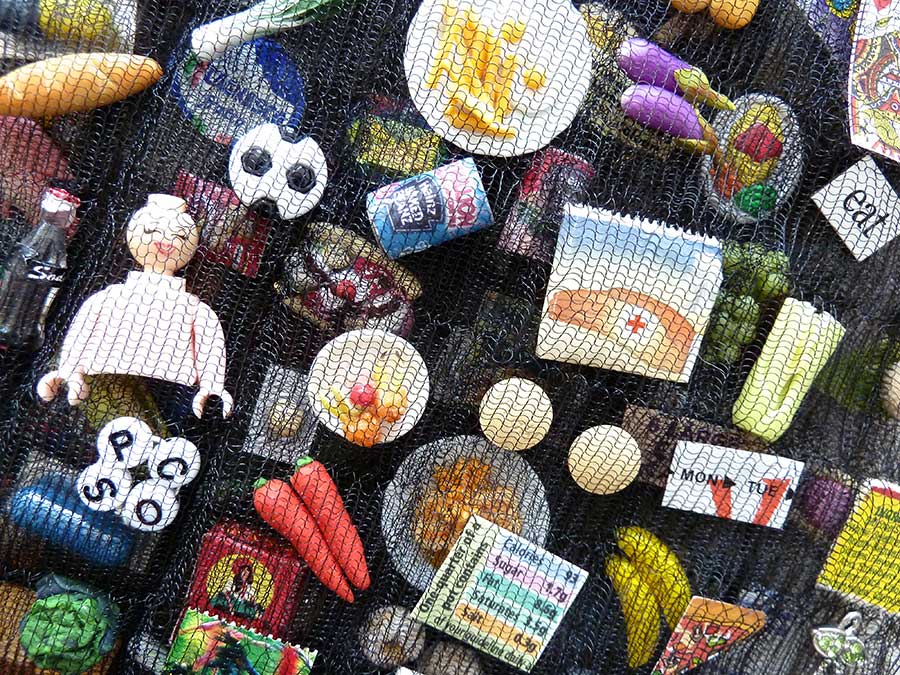
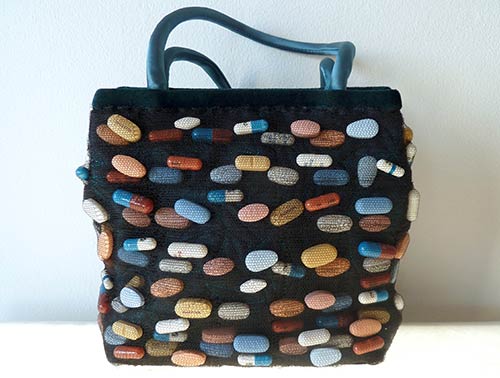 Nearly 100,000 people in the UK are living with HIV and up to 20,000 of these are currently undiagnosed. As life expectancy increases so does the number of people with HIV. Twice as many men as women are living with HIV, and more than half are between the ages of 35 and 49 years old. These days new transmission of HIV is more likely through exposure to heterosexual rather than homosexual sex. Many patients still feel there is stigma attached to the diagnosis. Although the drugs have transformed life expectancy it remains a very serious and distressing illness for many people.
Nearly 100,000 people in the UK are living with HIV and up to 20,000 of these are currently undiagnosed. As life expectancy increases so does the number of people with HIV. Twice as many men as women are living with HIV, and more than half are between the ages of 35 and 49 years old. These days new transmission of HIV is more likely through exposure to heterosexual rather than homosexual sex. Many patients still feel there is stigma attached to the diagnosis. Although the drugs have transformed life expectancy it remains a very serious and distressing illness for many people.
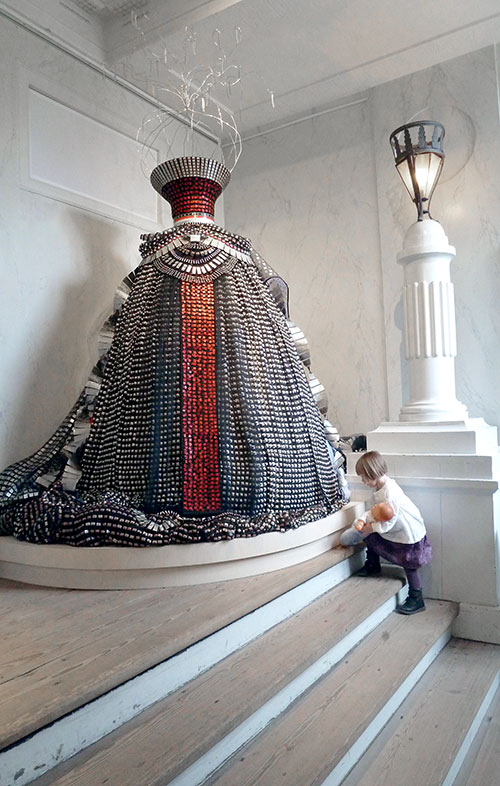
Pharmacopoeia’s sculptural figure explores the complexity of Metabolic Syndrome. At the core of the syndrome is a metabolic process called insulin resistance which is linked to increasing obesity. The consequences of this vary from person to person and may include high blood pressure, diabetes, high cholesterol and heart disease
We examined the real prescribing records of two individual patients, one Danish and the other from the UK. They are both women in their forties who have diabetes and high blood pressure plus a number of other medical problems. One has had a heart attack.
By amalgamating their two records we were able to ‘construct’ a third woman whom we call ‘Femme Vitale’. She has had diabetes for 10 years and a heart attack 4 years ago. Since developing these chronic diseases she has also had an episode of depression and developed arthritis in her knees.
Tablets and capsules are knitted into separate swathes of cloth, each representing a different element of the syndrome. The red ‘heart’ pills form a central core with the mass of diabetic medication flowing out from the 82cm waist. We have specifically chosen this measurement as research has shown that any woman with a waist measurement over 82cm is at increased risk of developing diabetes.
Packaged pills for high blood pressure twist in a helix while lipid lowering statins sweep out from the bustle. Ribbons and decorative details feature painkillers, indigestion medicine and aspirin taken after a heart attack. A ‘crown’ of antidepressants completes the artwork.
Many conditions are often treated with drugs that need to be taken regularly. The daily ritual of taking pills, sometimes every morning, noon and night is something people have to get used to.
For Daglig Dosis Liz Lee recreated her Bristol surgery with a combination of british and danish items including medical equipment, her doctors bag, desk, chairs, examination couch and small Pharmacopoeia artworks. On the walls is a long hand written chart documenting the daily movements of patients in and out of the room. Recorded only by age, sex and presenting problem, it documents a huge range of conditions and the relentlessness of the 10 minute appointment system which is used by most doctors in family practice.
It is estimated 272,250 antidepressant pills are taken each day in Denmark. In order to represent this quantity in a subjective way an average of 650 pills passed the camera every minute that the Daglig Dosis exhibition was open. These views were projected in a repeated cycle completely filling the large walk-through space, reflecting the overwhelming nature of depression on a personal basis.
Dr David Kessler writes:
“The symptoms of depression are pretty much the same the world over. Depression is like grief without an object. At its most severe, depression can cause a sufferer to stop eating and die.
“Not all cultures label it as depression. For example, in the Shona language in Zimbabwe it’s called Kifungisisu which means ‘the disease of thinking too much’. Women are twice as likely to suffer from depression as men, with the peak age for both genders being in the 30’s and 40’s. Very old people are much more likely to get prescribed an antidepressant.
“There are various theories about the neurobiology of depression based on the way the drugs work; we still don’t know for certain what causes depression at a neurobiological level. There isn’t a single gene for depression; if vulnerability to depression is inherited, it is a complex inheritance. We know that depression is more common in areas of social deprivation, and that personal trauma makes you more likely to become depressed, but we don’t know why some people get depressed in certain circumstances and some don’t. People with some physical diseases such as heart and lung disease are much more likely to become depressed.
“Depression and anxiety often go together, and both depression and anxiety are probably both under diagnosed and under treated in Denmark, as they are throughout the world. Antidepressant prescribing has trebled in Denmark since Prozac was introduced in the early 90’s. Although antidepressants are effective for severe depression, nobody knows for sure if they are any good for mild depression, and some kinds of psychotherapy work very well to alleviate depression.”
A companion work to Last Rites, First Love has two components. The first is a series of photographs which capture different people’s ideas about what that moment might be like. These are subjective responses to the question “how do you visualise what happens at the moment of conception?” They vary from ‘fish’, ‘fireworks’, ‘an egg’ (with a hard shell) or saying ‘no-no!’, to ‘flowers’ and ‘a sticky mess’. These were then re-interpreted visually in the hazy, sugary coloured effect of early digital video and photography to mirror people’s hazy ideas about one of the most important events in our lives.
The second component is a series of 35 intra uterine devices or coils which have all been used. We estimate that between them they have prevented at least 200 conceptions from occurring. They work by inhibiting the sperm which are trying to fertilise the released egg. They also prevent any of the eggs that do get fertilised from implanting and growing in the womb. The coils therefore operate at a number of stages in the process of conception.
First Love was originally presented as Recoil in 2000
Pharmacopoeia recently combined framed artworks, films, poems and a trampoline for an installation titled Charlie.
Cystic Fibrosis is a condition inherited via autosomal recessive genes. These genes cause a disturbance in the way sodium chloride is transported at a cellular level. This in turn causes all sorts of fluids in the body to be more viscous than normal and clog up various organs including the lungs. When a child is diagnosed with CF he or she immediately changes from being a normal child to a not normal child. Society views them as ‘different’ or ‘special’ and Charlie is one of these kids.
For 10 years we have been talking to him and his parents about the experience of his condition, the medicines he takes, his hours of daily treatment, times in hospital, scans and xrays. Charlie’s treatment has been directed at keeping his lungs as clear as possible by a combination of physiotherapy, inhalations and antibiotics to prevent infection.
While most of us are struggling not to get fat, Charlie is struggling not to get thin. Every time he eats he has to take between one and six enzyme capsules to replace the digestive enzymes he cannot produce naturally. Without these he can’t absorb enough nutrients from his gut and will become severely malnourished and die. He remains very cheerful in spite of having spent long months in hospital on more than one occasion.
Charlie’s mother Maz has researched the treatment of CF around the world and has been particularly interested in programs developed in Denmark. She says ‘I think medically the Danes have been very significant for CF – they have the best statistics globally as well as innovative doctors. The most influential piece of the Danish protocol for us was the use of the trampoline. Apparently they actually hand them out as part of treatment. As a result we always had a small home-sized trampoline in the house.’
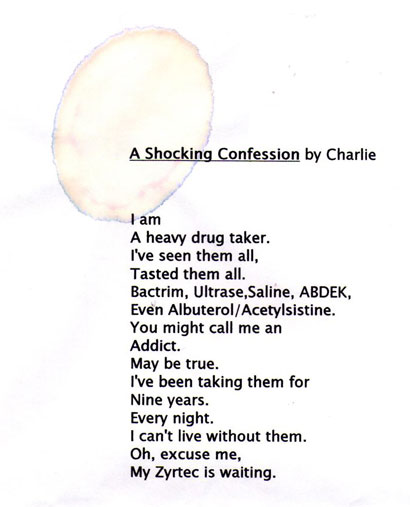
Last Rites is the companion piece to First Love. It has two components. The first is a series of photographs about the moment of death. We asked many people the question ”what is your image of the moment of death?“ Most responded initially by saying either everything goes black or that they see a bright white light. When pressed people went on to imagine other more detailed and specific visual images.
David Critchley used their words and over a period of a year took photos that responded to the ideas of the moment of death. In particular he echoed the dark/bright light idea and photographed predominantly black, white and grey subjects, although shot in colour. These were then added to photographs by other collaborators.
The second component is a series of framed ‘butterfly needles’ which are used to give drugs to dying patients. The needle is inserted under the skin and the tubing attached to a machine called a syringe driver. Drugs such as diamorphine are given to patient this way. The machine ensures the dose of drug is delivered constantly day and night to keep the dying patient as comfortable and free from distressing symptoms as is possible.
The syringe driver is started when a patient becomes too ill to take medication by mouth. It is now such a common part of terminal care that starting a ‘driver’ is akin to the Last Rites.
A Dutch version of Cradle to Grave, commissioned by SKOR (Foundation Art and Public Space) for ‘De Collectie: A New Context for Art Projects in Care Institutions’.
From September 2012 Wieg tot Graf will be on long-term display at CBG-MEB (medicines evaluation board), Utrecht.
dANTE OR dIE make interdisciplinary performances combining physical theatre, dance and live and recorded music, often reacting and responding to different sites and environments.
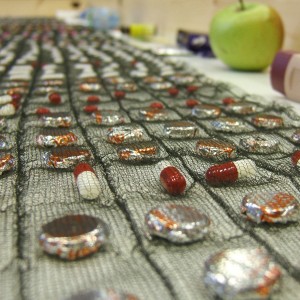 In a project for Holloway Women’s Prison initiated by The British Museum and funded by UCL, Pharmacopoeia developed Dose – an installation documenting a woman’s ‘life’ up to 50 years as seen through her prescribed medication.
In a project for Holloway Women’s Prison initiated by The British Museum and funded by UCL, Pharmacopoeia developed Dose – an installation documenting a woman’s ‘life’ up to 50 years as seen through her prescribed medication.
Liz Lee spent time with the prison medical service at Holloway to gain insight into the health problems of this particular population. Similar to Cradle to Grave a pocket knitted pill narrative with health related objects, documents and family album photographs was made and exhibited in the prison chapel in autumn 2009. Pharmacopoeia ran art workshops to explore issues raised by Dose that were significant and resonant for women prisoners in Holloway such as addiction, sexual and mental health. Through group art making exercises the women developed their own ideas in a variety of media with a particular focus on textiles and making bags.
BBC Horizon commissioned Pharmacopoeia to make a new version of our sweets and pills dress. Gretel was featured with other Pharmacopoeia pieces in the documentary titled ‘Pill Poppers’ directed by Emma Jay and first screened in January 2010.
Go to the original version of this piece ‘Sweetie’, made in 2000.
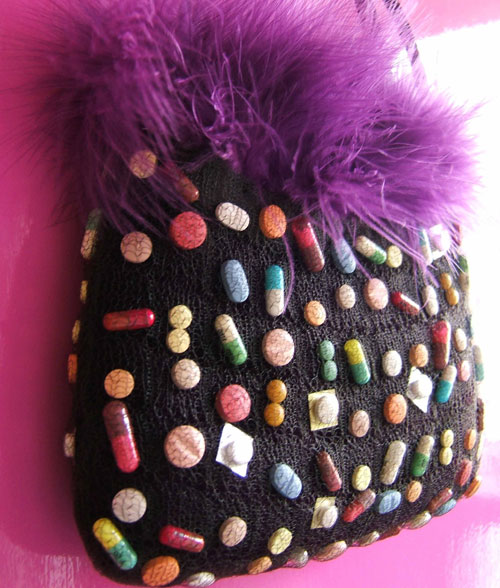 A handbag with a range of pills that may be taken by an agoraphobic to enable them to go out—it includes antidepressants, anxiolytics like valium to calm their nerves and beta blockers to steady their pounding heart.
A handbag with a range of pills that may be taken by an agoraphobic to enable them to go out—it includes antidepressants, anxiolytics like valium to calm their nerves and beta blockers to steady their pounding heart.
This is the latest in a edition of five Agoraphobic’s Handbags, some of which have been sold to private collectors.
White pain is made from the pill packaging that remains after one man’s lifetime of taking painkillers.
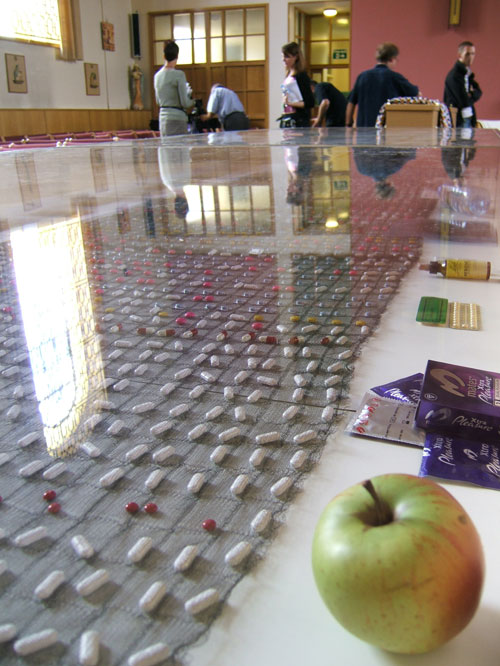 Co-ordinated by Jane Samuels for the Access programme at The British Museum, Pharmacopoeia exhibited a site specific Installation, A.N.Other, in the prison chapel at Pentonville Prison. Through the month of September 2006 David Critchley, Susie Freeman and Liz Lee ran related art workshops for prisoners focusing on the themes of life and death and the drug and pharmaceutical elements as presented in A.N.Other and Cradle to Grave.
Co-ordinated by Jane Samuels for the Access programme at The British Museum, Pharmacopoeia exhibited a site specific Installation, A.N.Other, in the prison chapel at Pentonville Prison. Through the month of September 2006 David Critchley, Susie Freeman and Liz Lee ran related art workshops for prisoners focusing on the themes of life and death and the drug and pharmaceutical elements as presented in A.N.Other and Cradle to Grave.
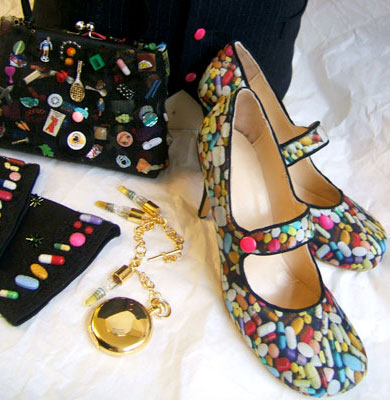 John Charnley, was considered by many to be the inventor of the the prosthetic hip. Pharmacopoeia were commissioned in 2005 by the John Charnley Trust to make a group of wearable pieces illustrating his research.
John Charnley, was considered by many to be the inventor of the the prosthetic hip. Pharmacopoeia were commissioned in 2005 by the John Charnley Trust to make a group of wearable pieces illustrating his research.
To address mobility lost through joint pain and pain management, our five pieces—waistcoat, pocket watch, handbag, gloves and shoes—resonate with patients on an intuitive and emotional level.
We make reference to what pain and stiffness stop you doing – like dancing, walking, going out to the shops, knitting, or playing the piano. The need to wear comfortable often unattractive shoes (no high heels any more) and having to use a walking stick. Medicines are included from the various classes of drug that are use to treat the pain of arthritis. The non steroidal anti-inflammatory drugs, paracetamol and the paracetamol/codeine drugs, the cytotoxic drugs methotrexate and gold injections. Phials of the latter were incorporated into a pocket watch and chain made by jeweler Holly Belsher. The waistcoat references John Charnley’s fabric infection charts which he made on pinstripe cloth.
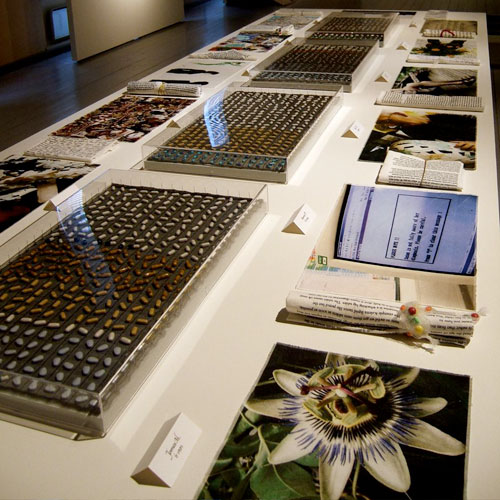 “Table Talk movingly explores the effect of HIV/AIDS on individuals’ lives. A dinner table is set for 12 real people whose life stories together tell the history of HIV/AIDS in the UK. Their varied experiences of living with HIV/AIDS and the deaths of some are described on their dinner napkins and place mats set around a table, decorated with a gauze runner that incorporates pharmaceutical samples to track the evolution of HIV/AIDS therapy.”
“Table Talk movingly explores the effect of HIV/AIDS on individuals’ lives. A dinner table is set for 12 real people whose life stories together tell the history of HIV/AIDS in the UK. Their varied experiences of living with HIV/AIDS and the deaths of some are described on their dinner napkins and place mats set around a table, decorated with a gauze runner that incorporates pharmaceutical samples to track the evolution of HIV/AIDS therapy.”
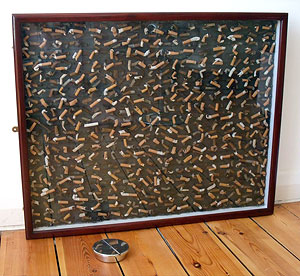 A framed length of fabric, containing all the cigarette butts collected over the course of a week from seven ashtrays in a school staffroom. It is shown alongside forensic photographs of the seven ashtrays.
A framed length of fabric, containing all the cigarette butts collected over the course of a week from seven ashtrays in a school staffroom. It is shown alongside forensic photographs of the seven ashtrays.
Since making it, smoking in the staffroom at this school has been banned.
 Miss Essex is an obese young diabetic woman with serious mental health problems. She regularly sees both her GP and her psychiatrist.
Miss Essex is an obese young diabetic woman with serious mental health problems. She regularly sees both her GP and her psychiatrist.
She is prescribed a diabetic tablet called Metformin which helps reduce blood sugar levels and Enalapril Maleate to lower her blood pressure.
She has also been prescribed a number obesity drugs. Orlistat reduces the absorption of fat from the intestine which can contribute to weight loss especially when combined with an appropriate diet. Fenfluramine is an appetite suppressant which used to be prescribed to obese people but was withdrawn following reports of serious side effects.
Her mental health problems are complex, including both depressive and psychotic illnesses. She has been prescribed a number of antidepressants such as Prozac and Mirtazepine. She has also taken Stelazine, an anti-psychotic drug, and in turn Procyclidine to combat some of the severe side effects of Stelazine.
One of the consequences of her poor mental health is that at times she continues to collect her prescriptions but does not take the drugs. These hoards of pills have been collected from her often months or years after they have been prescribed.
 Joe is 14 and started skateboarding when he was 11. He has needed stitches on his leg but fortunately had no fractures. The boards are broken quite frequently particularly ‘when you jump off high things’.
Joe is 14 and started skateboarding when he was 11. He has needed stitches on his leg but fortunately had no fractures. The boards are broken quite frequently particularly ‘when you jump off high things’.
Skateboarding is a sport that is generally good for the health, but it has its hazards and these include broken bones. The most common are injuries to the lower limbs especially fractures around the ankle. Wrists and hands are also vulnerable. Any part of the body can be injured and in accident and emergency departments ribs, backs and faces (including teeth) often need to be X-rayed. Sometimes there is a fracture, sometimes not. This is reflected in this collection of X-rays of skateboarding injuries gathered from three A&E departments. The most severe and life threatening injuries sustained while skateboarding are head injuries, principally caused by collision with moving vehicles while skateboarding on roads.
Prince Charles saw Headache amongst other pieces at the Harley Gallery in Nottinghamshire.
 This laboratory report from a urine sample graphically illustrates the problem of increased resistance. The patient presented with the symptoms of a urinary tract infection (UTI): the desire to pass small amounts of urine very frequently, accompanied by burning pain. This is a very common problem for women and standard management is to treat the infection ‘blind’ without sending a specimen to the laboratory. In children and in men UTI’s are uncommon and can be associated with significant underlying problems and so when they develop these symptoms a specimen must always be sent to the laboratory and the problem reviewed again after treatment has been given.
This laboratory report from a urine sample graphically illustrates the problem of increased resistance. The patient presented with the symptoms of a urinary tract infection (UTI): the desire to pass small amounts of urine very frequently, accompanied by burning pain. This is a very common problem for women and standard management is to treat the infection ‘blind’ without sending a specimen to the laboratory. In children and in men UTI’s are uncommon and can be associated with significant underlying problems and so when they develop these symptoms a specimen must always be sent to the laboratory and the problem reviewed again after treatment has been given.
In this case a specimen of urine was sent to the laboratory and revealed a highly resistant E. Coli bacterium. On the right hand side of the form is a list of antibiotics that it has been tested against. An R after the antibiotic name denotes resistance, an S denotes sensitivity. This particular bacterium is resistant to seven antibiotics. Fortunately there are two to which it is still sensitive and these can be used to treat the infection.
 Migraine headaches are common and often disabling. An initial constriction of blood vessels in the head cause characteristic visual disturbance called an aura in some sufferers. They know that this presages the onset of a severe headache as the vessels then dilate within the confined space of the skull. Nausea with or without vomiting accompanies the headache. The patient usually has no choice but to lie down, preferably in a quiet darkened room until the migraine passes. This can take from a very few hours to a few days. Occasionally transient partial paralysis occurs during a very severe migraine.
Migraine headaches are common and often disabling. An initial constriction of blood vessels in the head cause characteristic visual disturbance called an aura in some sufferers. They know that this presages the onset of a severe headache as the vessels then dilate within the confined space of the skull. Nausea with or without vomiting accompanies the headache. The patient usually has no choice but to lie down, preferably in a quiet darkened room until the migraine passes. This can take from a very few hours to a few days. Occasionally transient partial paralysis occurs during a very severe migraine.
Migraines can be triggered by a variety of stimuli. Twenty five percent of migraine sufferers believe their attacks can be provoked by foodstuff. Chocolate, caffeine, red wine and mature cheese are commonly cited. There is also some evidence that the following are also often implicated: wheat, oranges, eggs, milk, beef, corn, cane sugar, yeast, mushrooms and peas. Premenstrual and menstrual migraine are common as are post exercise migraine and stress induced migraine.
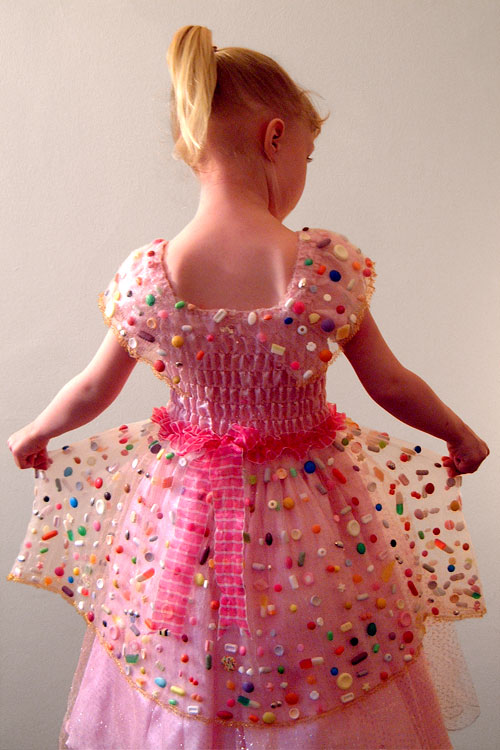 Pills are made to look like sweets in order to encourage us to take them and sometimes they can be virtually indistinguishable from each other. For example Ibuprofen looks very much like a smartie. This is perhaps not surprising as it’s pink sugary coating has been added specifically to ‘sweeten the pill’.
Pills are made to look like sweets in order to encourage us to take them and sometimes they can be virtually indistinguishable from each other. For example Ibuprofen looks very much like a smartie. This is perhaps not surprising as it’s pink sugary coating has been added specifically to ‘sweeten the pill’.
Children overdose on all kinds of drugs. They can be at risk when visiting elderly relatives who keep their tablets beside the bed or on a kitchen shelf.
The more ubiquitous and appealing a drug the more likely children are to accidentally overdose on it and the most common culprit is paracetamol elixir or calpol. This pink syrup can be found in almost all homes with a child under the age of six, and is so familiar that people forget to treat it as a medicine, leaving bottles within easy reach of inquisitive children.
Go to the new version of this piece ‘Gretel’, made for BBC Horizon in 2009.
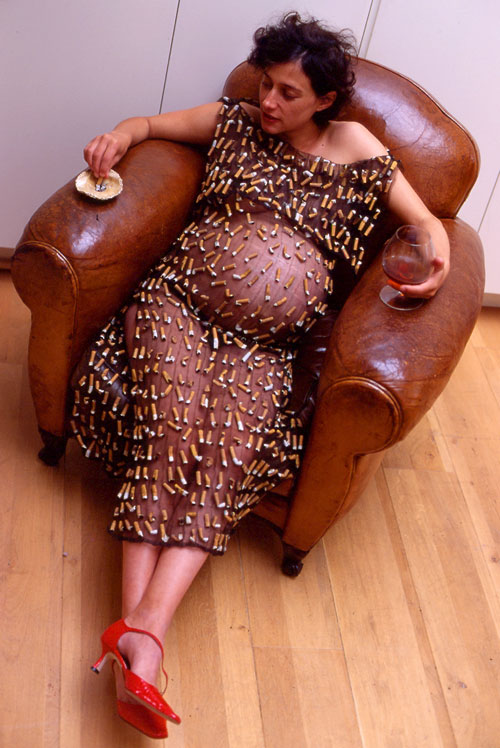 Pocket knitted dress containing 840 cigarette butts—a packet a week for an average pregnancy.
Pocket knitted dress containing 840 cigarette butts—a packet a week for an average pregnancy.
If you carry on smoking during pregnancy you are more likely to suffer complications while you are pregnant. Although small, there is a greater risk of having a miscarriage, bleeding, your waters breaking early – which can lead to the baby being born with an infection, your baby being born prematurely, giving birth to a still born child or your baby dying soon after it’s born.
On average a smoker’s baby will weigh 8oz (220g) less than a non-smoker’s. This may be because cigarette smoke reduces the amount of oxygen that the baby gets through the umbilical cord.
The following chemicals also pass into a baby’s blood-stream:
Photo: Chloe Stewart
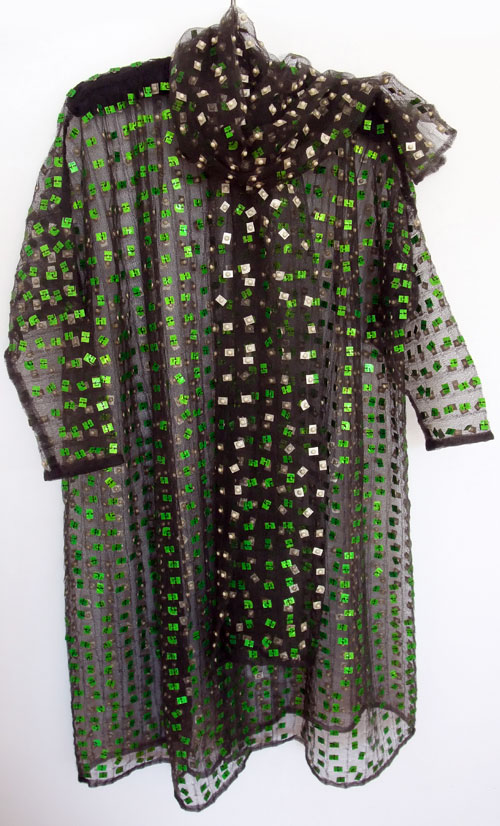 Microgynon, with its distinctive emerald and gold packaging, is one of the most popular contraceptive pills in the UK.
Microgynon, with its distinctive emerald and gold packaging, is one of the most popular contraceptive pills in the UK.
The Pill is not just prescribed as a contraceptive but also for painful, heavy, continuous or irregular periods and for premenstrual tension.
This coat and shawl contain enough pills to provide contraception for nine years.
 “We see a lot of people in surgery who are unhappy. One of the difficulties in general practice is deciding which of them have a clinical depression that may benefit from drug treatment as well as talking treatments such as psychotherapy, counselling or other forms of psychological support.
“We see a lot of people in surgery who are unhappy. One of the difficulties in general practice is deciding which of them have a clinical depression that may benefit from drug treatment as well as talking treatments such as psychotherapy, counselling or other forms of psychological support.
“From listening to Steve talking about his experience of clinical depression it becomes clear that this is very different from ordinary unhappiness.”
Dr Liz Lee
 “In responding to Liz Lee’s prompting on the general subject of depression, I immediately thought of my own down-times and how I might be able to relate to this subject as an artist. As ever, the things closest to one’s own experience and readily to hand became the metaphors for this most difficult to pin down illness. Collaboration and feedback from people close to me, and relating to places I know formed the backdrop for the patient / doctor discussion between Steve and Liz which we recorded and you as a viewer can share.”
“In responding to Liz Lee’s prompting on the general subject of depression, I immediately thought of my own down-times and how I might be able to relate to this subject as an artist. As ever, the things closest to one’s own experience and readily to hand became the metaphors for this most difficult to pin down illness. Collaboration and feedback from people close to me, and relating to places I know formed the backdrop for the patient / doctor discussion between Steve and Liz which we recorded and you as a viewer can share.”
David Critchley
www.critchley.net
A grommet fitted into the eardrum to improve hearing in children, a replacement intra-ocular lens fitted during a cateract extraction and a Blom-Singer valve, which gives speech after a laryngectomy. All three of these have been used and removed.
 When a doctor prescribes a medicine they write the generic name on the prescription form. The chemist makes the choice of which brand to give the patient. With repeat prescriptions, the pills recieved may look different. For example in this piece all sixteen tablets and capsules are the same drug – diclofenac. This is prescribed mainly to the elderly as a treatment for arthritis in conjunction with up to a dozen other pills a day. A change in appearance can only add to any confusion.
When a doctor prescribes a medicine they write the generic name on the prescription form. The chemist makes the choice of which brand to give the patient. With repeat prescriptions, the pills recieved may look different. For example in this piece all sixteen tablets and capsules are the same drug – diclofenac. This is prescribed mainly to the elderly as a treatment for arthritis in conjunction with up to a dozen other pills a day. A change in appearance can only add to any confusion.
 It has been estimated that, on average, each of us takes one course of antibiotics each year, 70% of which are amoxycillin.
It has been estimated that, on average, each of us takes one course of antibiotics each year, 70% of which are amoxycillin.
Since the use of antibiotics became widespread in the second half of the twentieth century many bacteria have become resistant to them. The more antibiotics we prescribe the more resistance develops and there are now major and justified concerns about the overuse of antibiotics. GP’s prescribe 80% of all antibiotics in the UK and therefore control of antibiotic resistance depends greatly on rational prescribing by these doctors.
 Made in 2000 for the Pharmacopoeia UK tour and subsequently shown in Scandinavia, Armour was recently purchased by the Royal College of General Practitioners where it is on permanent display in their headquarters on Euston Road.
Made in 2000 for the Pharmacopoeia UK tour and subsequently shown in Scandinavia, Armour was recently purchased by the Royal College of General Practitioners where it is on permanent display in their headquarters on Euston Road.
Armour was based on Liz Lee’s elderly patient Mr Brittain who suffered from emphysema, hypertension, heart failure, arthritis, indigestion and insomnia. Until the age of 50 he was relatively healthy but he did smoke. The smoking gradually destroyed the fabric of his lungs causing emphysema. It also contributed to the two heart attacks that together with his high blood pressure resulted in heart failure. He spent his last years sitting in his armchair breathing oxygen through a mask. Often in pain he could no-longer go out and had difficulty walking around his flat.
From his medical record we calculated all the oral prescription drugs he took between the age of 72 and 77 and sourced related empty pill packs. The resulting foil packaging scultpure represents the tough outer shell many people have to adopt in order to endure the suffering caused by the chronic diseases so common in old age.
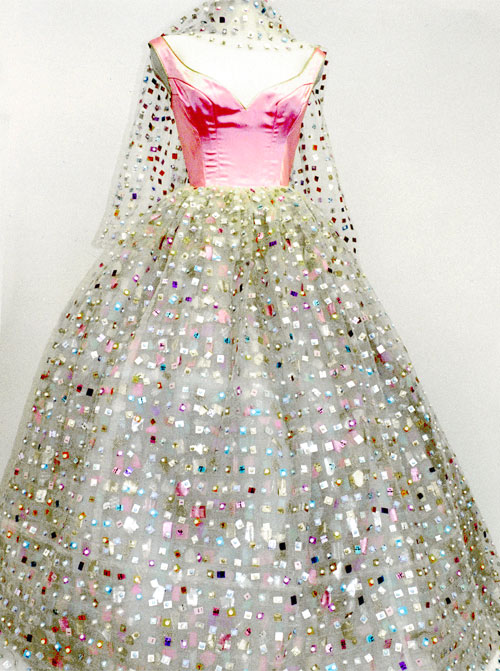
Armour and Jubilee were bought by The Royal College of General Practitioners in 2011 and are on public display in their central London headquarters next to Euston Station.
Jubilee is a wedding dress made of 80 denier nylon monofilament hand knitted on a Dubied industrial knitting machine. Enclosed in rows of tiny mesh pockets are 6,279 contraceptive pills. Allowing for a couple of breaks to have children this would provide contraception for a woman from the age of 22 to 50 years old.
Originally made in 2000 for the exhibition ‘Sexwise’, focusing on women’s health, Jubilee toured the UK from 2001 to 2003 and was part of Welcome Trust’s Medicine and Art exhibition in Tokyo 2010.

Ball gown incorporating the estimated 5,500 pills that would be needed to provide the equivalent 22 years of contraception provided by the Lippes Loop coil, which was fitted in a school cook following the birth of her fourth child and provided contraception until her menopause.
Photo: Neil Wilder
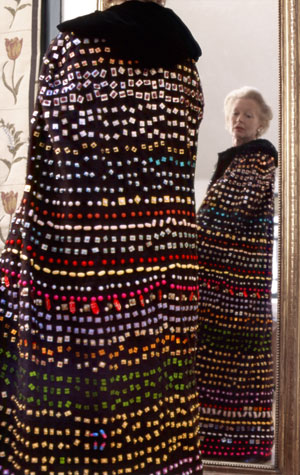 “Susie and I have been friends for 40 years and as women do we have had an ongoing conversation about periods, contraception and conception. ‘Under Wraps’ illustrates the menstrual narrative from menarche to menopause.”
“Susie and I have been friends for 40 years and as women do we have had an ongoing conversation about periods, contraception and conception. ‘Under Wraps’ illustrates the menstrual narrative from menarche to menopause.”
Dr Liz Lee
| Alternatives | Devil’s Claw |
| Contraceptives | Mercilon, Microgynon, Logynon, Cileste, Organon |
| Heavy Bleeding | Mefanamic Acid, Tranexamic Acid |
| Hormone Replacement Therapy | Prempack, Nuvelle, Tridestra, Progynova |
| Morning After Pill | Schering PC4 |
| Pain | Ibuprofen, Paracetamol, Coproxamol |
| POP Contraceptives | Loestrin, Neogest, Norimin |
| Thrush | Sopranox |
| Vitamins and Minerals | Premence, Iron, Primulot, B6 |
 Complementary therapies are increasingly popular. Some of these leaves, roots and seeds form the basis for both conventional and alternative medicines.
Complementary therapies are increasingly popular. Some of these leaves, roots and seeds form the basis for both conventional and alternative medicines.
|
|
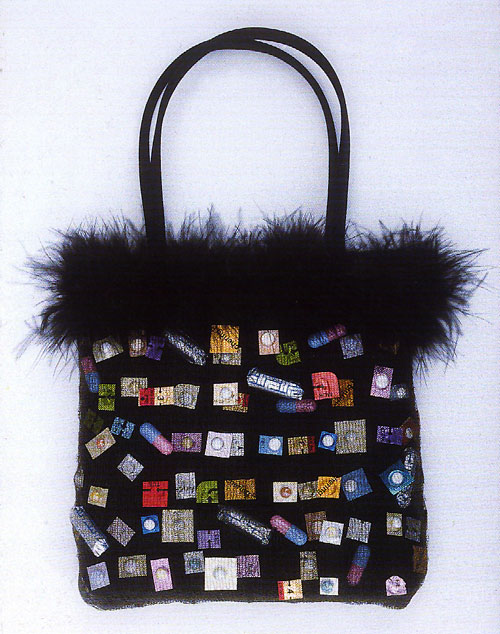 Decorated with varieties of the pill, condoms, pessaries and the morning after pill.
Decorated with varieties of the pill, condoms, pessaries and the morning after pill.
This handbag was made for the exhibition ‘Sexwise’, a collaboration between Pharmacopoeia, Nottingham Castle Museum & Art Gallery and the Health Authority in Nottingham, which focused on teenage pregnancy.
“An important part of the project involved the teenagers themselves making a video about the reality of teenage pregnancy. They were obviously enthusiastic, they learnt a lot through participating in that project and their experience has undoubtedly influenced them. Sexwise also worked brilliantly with the schools. We use the project as a model of good practice for health promotion in schools.”
Jocelyn Dodd
An artificial hip removed from a patient who had osteoarthritis is shown beside the estimated total number of pills they would have taken in lieu of having a prosthesis fitted.
One for the Road was shown in the context of other works and medical objects as part of Schmerz (Pain) in 2007 at the Hamburger Bahnhof – Museum der Gegenwart – Berlin:
“The exhibition PAIN traces the many expressions of pain: a picture of the crucifixion, the preserved specimen of a gouty hand, a video installation showing mourners, the flickering electric impulses of a nerve cell, a scream. Combining and confronting art works and objects from the realms of medicine, ethnology, religion and everyday usage, this exhibition ventures to make an expedition along the borderlines of art and medicine. It is intended as a laboratory for new visual and contextual impulses from the different spheres of imagery and objects, and is shown simultaneously in the Hamburger Bahnhof – Museum der Gegenwart – Berlin and in the Medizinhistorisches Museum (Museum of the History of Medicine) at the Charité, Berlin’s main hospital”
 “I came across Mr Minckton’s pile of unopened pills on a home visit. I asked him if he would like me to take them away. It made me realise how wasteful some of our prescribing habits can be. In fact nearly everyone has a quantity of unused drugs in their medicine cabinet”
“I came across Mr Minckton’s pile of unopened pills on a home visit. I asked him if he would like me to take them away. It made me realise how wasteful some of our prescribing habits can be. In fact nearly everyone has a quantity of unused drugs in their medicine cabinet”
Dr Liz Lee
 Clippy Story
Clippy StoryIn 1978 Joyce Adams was 58 and working as a bus conductor. One lunchtime as she jumped down from her bus to get a sandwich for her driver she fell and fractured her hip. This is called a fractured neck of femur (the femur is the long bone of the thigh). Treatment is an operation to remove the fractured end of the bone which forms part of the hip joint and replace it with an artificial hip joint.
Joyce walked around on her artificial hip for twenty years. It eventually started to become painful as its shaft worked loose where it was cemented into the femur. This necessitated a second operation to replace the artificial hip with a new one and this was performed in Southmead Hospital, Bristol.
Mrs. Adams is now walking around comfortably on her new hip and she gave us permission to use the old one in Hip Hip, permanently on display in the hospital’s out-patient department. Hip Hip enables patients awaiting a hip operation to see what an artificial joint looks like after twenty years of wear. This is contrasted with pills taken for arthritis which, apart from fractured hips is the main reason for patients to have a hip replacement. Patients are understandably very interested in the work as it directly relates to their own experience of illness.
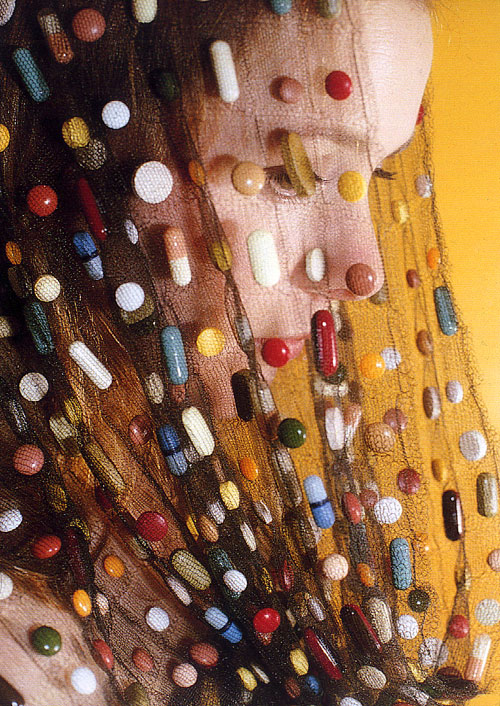 Easily available vitamins and minerals may look very similar to more dangerous prescription-only drugs.
Easily available vitamins and minerals may look very similar to more dangerous prescription-only drugs.
Photo: Chloe Stewart
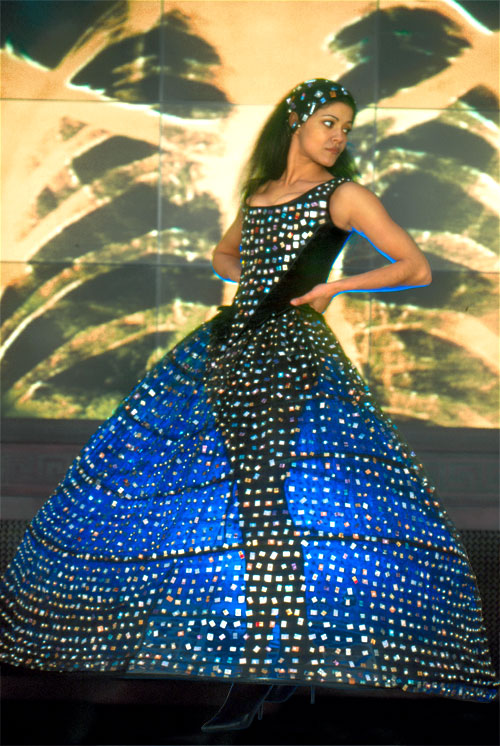 “Come Dancing is a dramatic ball gown decorated with over 6,000 multicoloured, foil covered oral contraceptives trapped in tiny net pockets, rather than appliquéd with sequins. At the waist, where a jewel clasp would be more appropriate, is a Lippes Loop, removed from a teacher for whom it had provided intrauterine contraception for 26 years, an equivalent period to that provided by the gown’s thousands of pills.
“Come Dancing is a dramatic ball gown decorated with over 6,000 multicoloured, foil covered oral contraceptives trapped in tiny net pockets, rather than appliquéd with sequins. At the waist, where a jewel clasp would be more appropriate, is a Lippes Loop, removed from a teacher for whom it had provided intrauterine contraception for 26 years, an equivalent period to that provided by the gown’s thousands of pills.
“The work resulted from consultations with patients about contraception, during which Dr Lee observed that, despite lacking a visual image of an interuterine contraceptive device, many women had such strong emotional feelings about the coil that they were unable to discuss its use rationally. In contrast, women choosing oral contraception were unlikely to realise the quantity of pills they would have to take over many years. By showing a Lippes Loop alongside the number of pills required to provide equivalent contraception, Come Dancing neatly reveals two previously hidden pieces of information, and helps to inform women about their preferred contraceptive method.”
Colin Martin, The Lancet
Photo: The Wellcome Trust